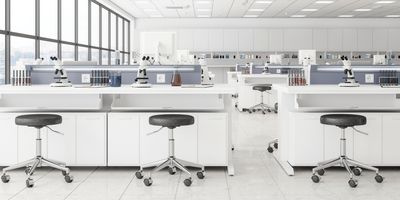Lab Furniture Safety Considerations
Keep these key safety factors in mind when selecting furniture for the laboratory
When purchasing lab furniture such as countertops, cabinets, seating, and storage, factors such as functionality, comfort, and aesthetics might be top of mind. But it’s also important to consider safety as a primary decision criterion. The design, installation, and maintenance of furniture can play a significant role in promoting a safe and efficient workspace.
As Jonathan Klane, senior safety editor at Lab Manager, explains, laboratory furniture safety must comply with a range of rules and regulations and satisfy multiple stakeholders. These often include fire marshals, chemical hygiene officers, and biosafety officers, among others.
Materials and construction are key for lab suitability
When it comes to lab furniture safety, choosing the right materials and construction is essential. Acceptable materials for items such as countertops and cabinets often depend on the laboratory’s specific needs, including the applications carried out and the types of chemicals used. Still, there are usually commonalities across all labs.
As Klane explains, the fire marshal will want to ensure that furniture materials are flame-retardant. They should also be non-reactive with any reagents, products, and cleaning solutions they may come in contact with. Another concern in many labs is electrostatic discharge (ESD), which can damage sensitive components. In this case, opting for furniture constructed of ESD-safe materials may be necessary.
Meanwhile, the biosafety officer will focus on ensuring that materials are easy to clean and sterilize to avoid the risk of contamination. In addition, furniture with sealed seams, non-porous surfaces, and antimicrobial coatings can help prevent the buildup of bacteria and other pathogens.
When it comes to lab furniture safety, choosing the right materials and construction is essential.
After selecting the right equipment, it must be installed and used correctly. Examples include closely following the manufacturer’s assembly instructions and using the correct hardware to install items such as shelving and cabinetry. Once installed, furniture should be used per manufacturer guidelines and properly maintained and repaired as needed.
Other factors include ergonomics and layout
While safety concerns often focus on accidents and major hazards, the furniture we use daily can impact our long-term health. Ensuring that workspaces are ergonomically sound is vital and might involve considering everything from chair angles to desk heights to cupboard hardware. It’s a good idea to seek advice from an ergonomics expert prior to purchasing furniture, as it’s typically difficult to make adjustments after installation.
It’s also crucial to plan the layout of furniture correctly. In a bid to increase storage and bench space, it’s tempting to try to squeeze in too many items. The resulting cramped workspace can lead to an increased risk of accidents and could possibly violate fire safety regulations. Klane notes that the National Fire Protection Association’s (NFPA’s) Life Safety Code is commonly consulted in these cases, although other jurisdiction-specific standards and codes may apply.
Klane adds that chemical hygiene officers will want to know how chemicals are being stored and segregated, which will be a key consideration when planning the laboratory layout. Current and future capacity requirements should be considered—storage units quickly fill up, and overfilled cabinets increase the likelihood of chemicals ending up in an unsuitable location.
Safety should be a top priority when purchasing and using laboratory furniture. It’s important to consider a range of factors, such as materials, construction, ergonomics, and layout. Ultimately, investing in high-quality, safe furniture is essential for maintaining a productive and healthy laboratory environment.

